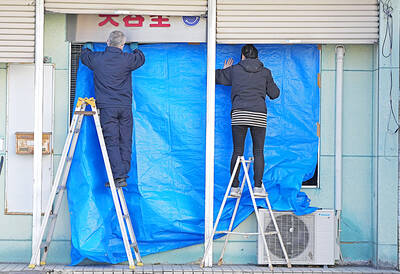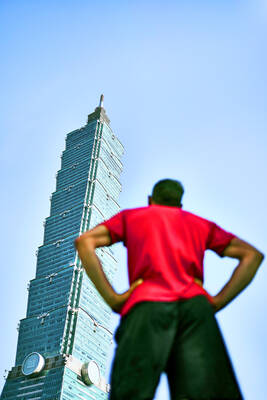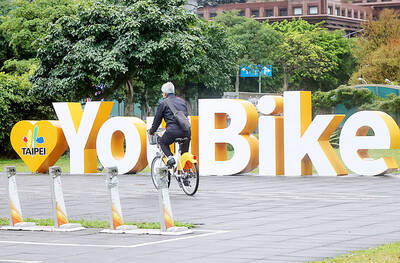On a chilly Saturday late last month, Green Party Taiwan (GPT) candidate for the Da-an District (大安) legislative by-election Calvin Wen (溫炳原) was removed from a camphor tree at the site of the old Songshan Tobacco Factory, after spending 27 hours in it in an attempt to prevent it being cut down.
Wen was subsequently arrested, along with several of his supporters, for interfering with police duties.
While some may view the escapade as a one-off, the tree-hugging episode was actually the culmination of a battle between a group of environmentalists and the Taipei City Government that began in 2006.
Aside from the Green Party, a number of other activists from groups including the Anti-Taipei Dome Association (ATDA) have attempted to force the city to change its decision to build the Taipei Dome Complex.
“We are not trying to save the tree per se. What we’re trying to do is save the land from being handed to Farglory Group in a build-operate-transfer [BOT] deal,” GPT Secretary-General Pan Han-shen (潘翰聲) said.
Citing a survey conducted by his organization with residents, ATDA president Arthur Yo (游藝) said that “more than 80 percent of residents think the site should instead be used as Taipei’s second forest park.”
“The Songshan Tobacco Factory, built in the 1930s ceased operations in 1998,” Pan said.
Since then, thick vegetation has grown at the site, harboring many rare animal species, he said, adding that the city had made several unlawful maneuvers to clear the site for the complex.
“In 2003, the Department of Cultural Affairs and the Department of Education proposed to use the site for the Taipei Sports and Culture Park and to build a sports dome as part of the ‘sports’ section of the park,” Yo said. “The two departments filed a Environmental Impact Assessment [EIA] proposal with the city’s Department of Environmental Protection, which was approved the same year.”
“However, in 2006 the department of education handed the sports dome part to Farglory as a BOT project,” Yo said.
In addition to the NT$23 billion (US$695.9 million), 40,000-seat indoor-sports dome, Farglory proposed adding a department store with restaurants and movie theaters, a luxury hotel with a business center and an office building, Yo said.
“Given the extent of the changes to the initial plan, Farglory must do a new EIA … and this has yet to be done,” he said.
Moreover, to dodge the problem of having to preserve old trees, the department of education intentionally omitted many of the trees on the preservation list in the 2003 EIA, Yo said.
“According to tree preservation regulations, any tree that is more than 50 years old must be preserved. But many of the trees at the site did not make the list. According to the law, if during removal or replanting a preserved tree dies, a fine has to be paid,” Yo said.
To underscore his point, Yo searched high and low for photographs of the tobacco factory when it was still operational and found a 1948 picture from Academia Sinica’s digital archive that proved that the trees had been there since at least that time.
In 2006, the city government began to remove the trees ahead of construction, Yo said. “Among the 689 trees, 384 were moved to a preservation site and 103 died,” he said.
In addition, the removals went against the regulations contained in the 2003 EIA.
“According to the documents approved by the city, the Department of Education could only begin work — including the removal of trees and buildings — after seven conditions have been met,” Yo said.
“These include hosting a meeting with residents, reviewing the preservation measures for the remaining buildings and planning a site to dump removed materials,” he said.
In 2007, Yo’s association filed a civil lawsuit against the department for illegal removal of the trees. They won.
“In September, the environmental department issued two NT$300,000 fines to the department for failing to comply with the EIA’s regulations,” Yo said. “What raises questions, however, is that while I filed the lawsuit in July 2007, in August Farglory applied to the environmental department to have the ‘demolition of old buildings’ and ‘removal of old trees’ clauses removed from the construction plan, arguing that preparatory work should be done by the city prior to handing the land over to Farglory.”
If the deletion were approved, Farglory would have immunity even if it removed trees before meeting the seven conditions prescribed in the 2003 EIA, Yo said.
The removal was approved in September.
“The department of culture received a copy of the 1948 picture and said it could not be determined with certainty that the trees in the picture were the same trees that are there today,” Yo said.
Since then, the Department of Education has removed the remaining 305 trees — 209 of which the city’s Tree Preservation Committee said had to be preserved — Yo said.
On Jan. 23, with only 23 trees left, lawyer Lin San-chia (林三加), chair of the Environmental Law Committee of the Taipei Bar Association, filed for a provisional disposition against the Department of Education at the Taipei High Administrative Court seeking to bar it from removing more trees before a new EIA was conducted.
“We received a notice saying that court day was Feb. 27, but the department went ahead and began removing trees on Feb. 24,” Lin said.
When, on court day, the two parties awaited the verdict, the last tree — the camphor tree that became famous thanks to Wen — was removed, Lin said.
Showing a copy of the Tree Preservation Committee’s timeline for tree removal, Yo said the process was about one month ahead of schedule.
“It is obvious that they wanted to dig out every single tree before the court could order them to stop,” he said.
Yo said there was no need for more shopping malls and concrete next to Guangfu Elementary School, where his son is a student.
“Guangfu — with more than 3,000 students the largest elementary school in Taipei — is just across the street from the Dome. Imagine a 70m high, gigantic complex towering over the schoolyard. What are the students going to do with all that noise from construction and sports events?” he asked.
What Taipei needs to become a first-rate city, is a central park, Lin said.
“The land is the shared property of all residents of Taipei and should be put to better use than allowing big business to profit from it,” he said.
In response, executive secretary of the Taipei Cultural and Sports Park Lee Kan (李侃) said removing the trees was completely legal, as “we are acting according to the first EIA before the second is passed.”
Lee said the contract stipulates that the city will hand over the property to Farglory before the end of this month.
Asked about the early removal of the trees, Lee said that Tree Protection Committee officials had inspected the site and that warmer weather had made it possible to remove the trees earlier than planned.

Taiwanese were praised for their composure after a video filmed by Taiwanese tourists capturing the moment a magnitude 7.5 earthquake struck Japan’s Aomori Prefecture went viral on social media. The video shows a hotel room shaking violently amid Monday’s quake, with objects falling to the ground. Two Taiwanese began filming with their mobile phones, while two others held the sides of a TV to prevent it from falling. When the shaking stopped, the pair calmly took down the TV and laid it flat on a tatami mat, the video shows. The video also captured the group talking about the safety of their companions bathing

US climber Alex Honnold is to attempt to scale Taipei 101 without a rope and harness in a live Netflix special on Jan. 24, the streaming platform announced on Wednesday. Accounting for the time difference, the two-hour broadcast of Honnold’s climb, called Skyscraper Live, is to air on Jan. 23 in the US, Netflix said in a statement. Honnold, 40, was the first person ever to free solo climb the 900m El Capitan rock formation in Yosemite National Park — a feat that was recorded and later made into the 2018 documentary film Free Solo. Netflix previewed Skyscraper Live in October, after videos

Starting on Jan. 1, YouBike riders must have insurance to use the service, and a six-month trial of NT$5 coupons under certain conditions would be implemented to balance bike shortages, a joint statement from transportation departments across Taipei, New Taipei City and Taoyuan announced yesterday. The rental bike system operator said that coupons would be offered to riders to rent bikes from full stations, for riders who take out an electric-assisted bike from a full station, and for riders who return a bike to an empty station. All riders with YouBike accounts are automatically eligible for the program, and each membership account

A classified Pentagon-produced, multiyear assessment — the Overmatch brief — highlighted unreported Chinese capabilities to destroy US military assets and identified US supply chain choke points, painting a disturbing picture of waning US military might, a New York Times editorial published on Monday said. US Secretary of Defense Pete Hegseth’s comments in November last year that “we lose every time” in Pentagon-conducted war games pitting the US against China further highlighted the uncertainty about the US’ capability to intervene in the event of a Chinese invasion of Taiwan. “It shows the Pentagon’s overreliance on expensive, vulnerable weapons as adversaries field cheap, technologically